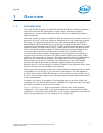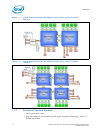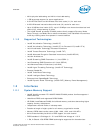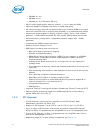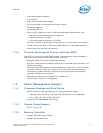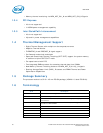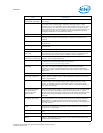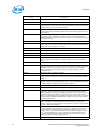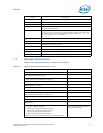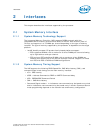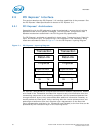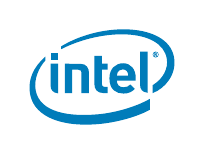
Intel® Xeon® Processor E5-1600/E5-2600/E5-4600 Product Families 19
Datasheet Volume One
Overview
• Home snoop based coherency
•3-bit Node ID
• 46-bit physical addressing support
• No Intel QuickPath Interconnect bifurcation support
• Differential signaling
• Forwarded clocking
• Up to 8.0 GT/s data rate (up to 16 GB/s direction peak bandwidth per port)
— All ports run at same operational frequency
— Reference Clock is 100 MHz
— Slow boot speed initialization at 50 MT/s
• Common reference clocking (same clock generator for both sender and receiver)
• Intel® Interconnect Built-In-Self-Test (Intel® IBIST) for high-speed testability
• Polarity and Lane reversal (Rx side only)
1.2.5 Platform Environment Control Interface (PECI)
The PECI is a one-wire interface that provides a communication channel between a
PECI client (the processor) and a PECI master (the PCH).
• Supports operation at up to 2 Mbps data transfers
• Link layer improvements to support additional services and higher efficiency over
PECI 2.0 generation
• Services include CPU thermal and estimated power information, control functions
for power limiting, P-state and T-state control, and access for Machine Check
Architecture registers and PCI configuration space (both within the processor
package and downstream devices)
• PECI address determined by SOCKET_ID configuration
• Single domain (Domain 0) is supported
1.3 Power Management Support
1.3.1 Processor Package and Core States
• ACPI C-states as implemented by the following processor C-states:
— Package: PC0, PC1/PC1E, PC2, PC3, PC6 (Package C7 is not supported)
— Core: CC0, CC1, CC1E, CC3, CC6, CC7
• Enhanced Intel SpeedStep® Technology
1.3.2 System States Support
• S0, S1, S3, S4, S5
1.3.3 Memory Controller
• Multiple CKE power down modes
• Multiple self-refresh modes





